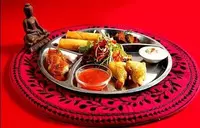The tibetan

You are what you eat.
Tibet is a mysterious Asian country that is located in hard-to-reach mountainous areas of the Tibetan Highlands. Nowhere in the world will you meet what can be seen in Tibet.
The unique, centuries-old, not fully studied and mystical history and culture of the Tibetan people goes back centuries. The history of modern Tibet began in the middle of the 20th century, when a mighty Chinese neighbor decided to get Tibetan lands.
The Chinese invaded the peace-loving Buddhist country with significant military forces, which led to the massacre of local residents and to thousands of refugee camps. The Chinese decided to wipe out not only the independent state of Tibet, but the oldest monuments of the Buddhist religion. Before the Chinese invasion, Tibet had more than 6, 000 monasteries and 114, 000 monks, with 8 monasteries and 800 Buddhist monks remaining in the mid-70s.
Until the mid-90s of the last century, Tibet was closed to foreigners. Until now, the Chinese authorities claim that the lands of Tibet rightfully belong to the PRC. However, the world community and ordinary people condemn the atrocities committed by Chinese soldiers, pouring Tibetan blood over the sacred lands.
The entire population of Tibet is professed by Buddhism, their spiritual teacher and mentor Dalai Lama XIV resides outside Tibet in India and leads the government in exile. Lama decided to take such a step only after a huge number of attempts were made on him.
Tibetan cuisine recipes belong to the same characteristic features of Tibetan culture as Buddhism. Tibetan cuisine has never been different in its diversity. Tibetan cuisine was greatly influenced by the climate and location of the state.
Since ancient times, the population of Tibet has been engaged in cattle breeding and the cultivation of livestock crops. Therefore, all Tibetan cuisine recipes can be divided into nomad cuisine and landowner cuisine. Nomads differ from ordinary people not only in their lifestyle, but also in their diet.
The basis of Tibetan cuisine for nomadic peoples was meat products. Most often they eat lamb and goat. The meat was cooked in plain milk and received a dish of Cho, which is perfectly combined with Chura cheese. Tibetans cook yak meat, which has been naturally dried and served with green tea and Tsampa.
Tsampa is a famous Tibetan bread made from fried barley flour and yak milk cheese. Yak milk is a separate and important topic for Tibetan cuisine. Tibetans make many of their dishes on milk. Hearty milk rustic milk, mar butter or cheese. Buttermilk in Tibet is used to make soft Chura Loen-Pa cheese or vice versa very hard Chura Campo cheese. Sometimes cheese is saved in Tibet and a Tibetan dish like Chhurpi is obtained.
The cuisine of landowners was characterized by more vegetable dishes, as well as pork, fish is not used to this day in Tibetan dishes. Tibetan Momos borrowed the cuisines of other Asian states. These are Tibetan dumplings that are made from vegetables or meat. Fresh dumplings are steamed and often lightly roasted to a ruddy crust.
Among the recipes of Tibetan cuisine, you can find the first dishes, which, however, are not so popular. However, Tungpa soup, which is cooked on a broth with noodles and vegetables, is unlikely to be abandoned by an ordinary Tibetan. End the meal In Tibet, it is customary to have Suima or Bo tea. This is a kind of Tibetan butter tea that is brewed from pressed leaves of the Puer variety on yaka milk.
If you find yourself a guest in the house of a Tibetan, then you will be served this tea in a small cup, as soon as you drink one cup, caring owners will immediately pour another on you. Therefore, the average resident of Tibet drinks about 40 cups of tea per day.
 Español
Español Français
Français Português
Português Русский
Русский 简体中文
简体中文 繁體中文
繁體中文 日本語
日本語 한국어
한국어 العربية
العربية Türkçe
Türkçe Қазақ
Қазақ Deutsch
Deutsch Italiano
Italiano Українська
Українська
